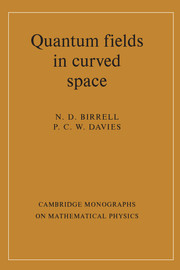Book contents
- Frontmatter
- Contents
- Preface
- Preface to the paperback edition
- Conventions and abbreviations
- 1 Introduction
- 2 Quantum field theory in Minkowski space
- 3 Quantum field theory in curved spacetime
- 4 Flat spacetime examples
- 5 Curved spacetime examples
- 6 Stress-tensor renormalization
- 7 Applications of renormalization techniques
- 8 Quantum black holes
- 9 Interacting fields
- References
- Index
1 - Introduction
Published online by Cambridge University Press: 05 August 2012
- Frontmatter
- Contents
- Preface
- Preface to the paperback edition
- Conventions and abbreviations
- 1 Introduction
- 2 Quantum field theory in Minkowski space
- 3 Quantum field theory in curved spacetime
- 4 Flat spacetime examples
- 5 Curved spacetime examples
- 6 Stress-tensor renormalization
- 7 Applications of renormalization techniques
- 8 Quantum black holes
- 9 Interacting fields
- References
- Index
Summary
The last decade has witnessed remarkable progress in the construction of a unified theory of the forces of nature. The electromagnetic and weak interactions have received a unified description with the Weinberg–Salam theory (Weinberg 1967, Salam 1968), while attempts to incorporate the strong interaction as described by quantum chromodynamics into a wider gauge theory seem to be achieving success with the so-called grand unified theories (Georgi & Glashow 1974, for a review see Cline & Mills 1978).
The odd one out in this successive unification is gravity. Not only does gravity stand apart from the other three forces of nature, it stubbornly resists attempts to provide it with a quantum framework. The quantization of the gravitational field has been pursued with great ingenuity and vigour over the past forty years (for reviews see Isham 1975, 1979a, 1981) but a completely satisfactory quantum theory of gravity remains elusive. Perhaps the most hopeful current approaches are the supergravity theories, in which the graviton is regarded as only one member of a multiplet of gauge particles including both fermions and bosons (Freedman, van Nieuwenhuizen & Ferrara 1976, Deser & Zumino 1976; for a review see van Nieuwenhuizen & Freedman 1979).
In the absence of a viable theory of quantum gravity, can one say anything at all about the influence of the gravitational field on quantum phenomena? In the early days of quantum theory, many calculations were undertaken in which the electromagnetic field was considered as a classical background field, interacting with quantized matter.
Information
- Type
- Chapter
- Information
- Quantum Fields in Curved Space , pp. 1 - 9Publisher: Cambridge University PressPrint publication year: 1982
